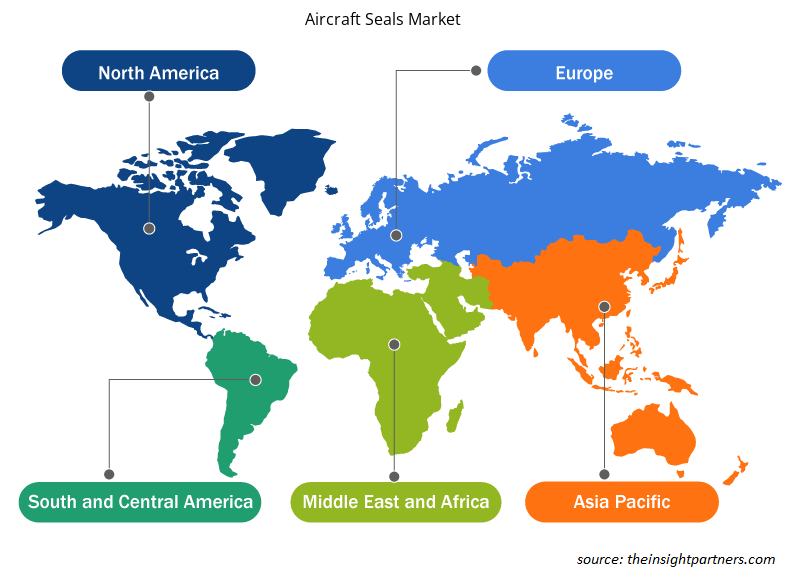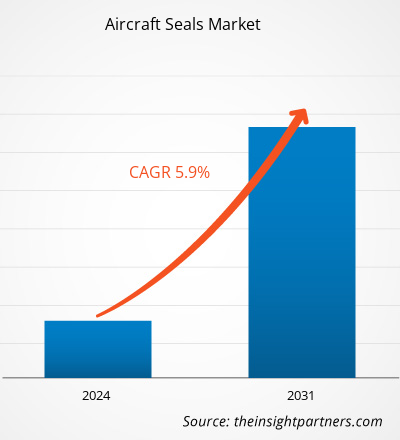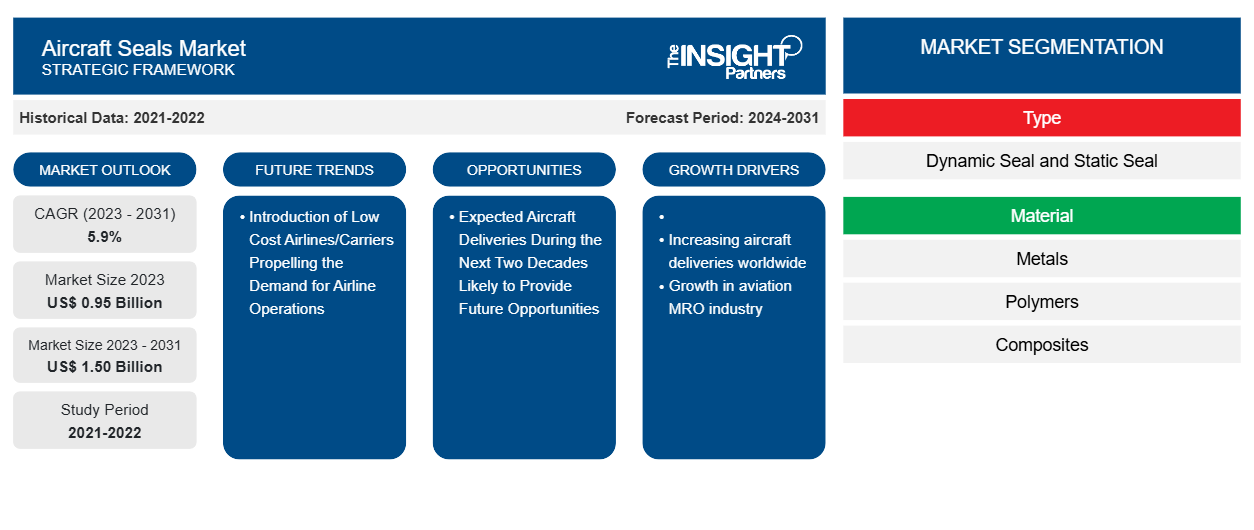La taille du marché des joints d'étanchéité pour avions devrait atteindre 1,50 milliard USD d'ici 2031, contre 0,95 milliard USD en 2023. Le marché devrait enregistrer un TCAC de 5,9 % en 2023-2031. L'industrie aéronautique devient de plus en plus sophistiquée avec l'émergence et l'acceptation rapide de matériaux légers et durables. Les joints de type conventionnel étaient fabriqués à partir de métaux durcis ; cependant, au cours des dernières années, les fabricants d'avions et de composants d'avions, ainsi que les exploitants d'avions, recherchent des joints légers tels que des joints à base de polymère et des joints à base de composite. Ce facteur reflète une demande accrue de joints à base de polymère et de composite, ce qui stimule le marché.
Analyse du marché des joints d'étanchéité pour avions
L'augmentation des volumes de commandes et de production d'avions soutient la croissance du marché des joints d'étanchéité pour avions par le biais du segment OEM. D'autre part, le segment du marché des pièces de rechange fait référence aux revenus générés par la vente de joints d'étanchéité pour avions aux prestataires de services MRO indépendants, aux installations MRO internes des compagnies aériennes et aux forces militaires. L'existence d'une flotte d'avions plus ancienne chez de nombreuses compagnies aériennes exige le remplacement et l'entretien des joints d'étanchéité pour avions. Le segment du marché des pièces de rechange sur le marché des joints d'étanchéité pour avions est relativement petit car les joints sont produits avec une durée de vie plus longue.
Aperçu du marché des joints d'étanchéité pour avions
Le marché des joints d'étanchéité pour avions devrait connaître une forte croissance dans les années à venir. La croissance du marché est propulsée par certains des facteurs dynamiques suivants :
- Augmentation des livraisons d'avions dans le monde entier
- Croissance du secteur de la maintenance, réparation et révision (MRO) dans le secteur aéronautique
- Croissance de la flotte d'avions dans différentes régions
- Les principaux retards des principaux constructeurs aéronautiques
Ces facteurs sont susceptibles d'avoir un impact significatif sur la croissance positive du marché des joints d'étanchéité pour avions. Parmi les autres facteurs majeurs susceptibles de stimuler le marché, on peut citer l'augmentation des achats d' avions militaires , l'introduction de compagnies aériennes à bas prix et de transporteurs à bas prix (LCA/LCC) qui stimulent la demande d'opérations aériennes et, en fin de compte, la demande de ventes sur le marché secondaire.
Personnalisez ce rapport en fonction de vos besoins
Vous bénéficierez d'une personnalisation gratuite de n'importe quel rapport, y compris de certaines parties de ce rapport, d'une analyse au niveau des pays, d'un pack de données Excel, ainsi que de superbes offres et réductions pour les start-ups et les universités.
-
Obtenez les principales tendances clés du marché de ce rapport.Cet échantillon GRATUIT comprendra une analyse de données, allant des tendances du marché aux estimations et prévisions.
Moteurs et opportunités du marché des joints d'étanchéité pour avions
Augmentation de la taille de la flotte mondiale d'avions
L'augmentation de la taille de la flotte d'avions est l'un des principaux facteurs catalysant la croissance du marché mondial des joints d'étanchéité pour avions. En 2023, la flotte mondiale d'avions commerciaux s'élevait à 27 385 avions (dont 8 122 en Amérique du Nord, 6 362 en Europe, 8 756 en Asie-Pacifique et 4 145 dans le reste du monde), pour atteindre 28 398 avions commerciaux en 2024 (dont 8 231 en Amérique du Nord, 6 533 en Europe, 9 263 en Asie-Pacifique et 4 371 dans le reste du monde). Cette augmentation de la flotte a stimulé la demande de joints d'étanchéité pour avions dans différentes régions au cours de l'année écoulée.
Les livraisons d'avions prévues au cours des deux prochaines décennies devraient offrir des opportunités futures
Les livraisons prévues au cours des vingt prochaines années devraient générer de nouvelles opportunités pour les fabricants de composants aéronautiques, notamment les fabricants de joints d'étanchéité pour avions. Par exemple, selon les prévisions de livraison d'avions commerciaux de Boeing et d'Airbus, plus de 40 800 appareils devraient être livrés au cours de la période 2023-2042. Ce nombre devrait augmenter la demande de nouveaux produits d'étanchéité pour avions et devrait stimuler le marché mondial des joints d'étanchéité pour avions dans les années à venir.
Analyse de segmentation du rapport sur le marché des joints d'étanchéité pour avions
Les segments clés qui ont contribué à l’élaboration de l’analyse du marché des joints d’aéronefs sont le type, le matériau, l’application, le canal de distribution, l’utilisateur final et la géographie.
- En fonction du type, le marché a été classé en joint dynamique et joint statique. Le segment des joints dynamiques détenait une part de marché plus importante en 2023.
- En termes de matériaux, le marché a été segmenté en métaux, polymères et composites. Le segment des polymères détenait la plus grande part du marché en 2023.
- En termes d'application, le marché a été segmenté en cellule, moteur, train d'atterrissage , commande de vol et système hydraulique, etc. Le segment de la cellule a dominé le marché en 2023.
- En termes de canal de distribution, le marché a été segmenté en OEM et après-vente. Le segment OEM a dominé le marché en 2023.
- En termes d'utilisateur final, le marché a été segmenté en avions commerciaux et avions militaires. Le segment des avions commerciaux a dominé le marché en 2023.
Analyse des parts de marché des joints d'étanchéité pour avions par zone géographique
La portée géographique du rapport sur le marché des joints d’aéronefs est principalement divisée en cinq régions : Amérique du Nord, Europe, Asie-Pacifique, Moyen-Orient et Afrique et Amérique du Sud.
L'Amérique du Nord a dominé le marché des joints d'étanchéité pour avions en 2023, tandis que la région Asie-Pacifique devrait connaître une croissance significative au cours de la période de prévision. La région nord-américaine comprend les États-Unis, le Canada et le Mexique. Les États-Unis ont dominé le marché nord-américain en 2023. Cela est principalement dû à l'augmentation du trafic de passagers aériens et à l'augmentation de la taille de la flotte d'avions à travers le pays. En outre, les futures livraisons d'avions au cours des vingt prochaines années généreront également de nouvelles opportunités pour les fournisseurs du marché de la région Amérique du Nord. Par exemple, selon le rapport Airbus Global Market Forecast, plus de 6 970 avions commerciaux devraient être livrés entre 2023 et 2042. Cela générera une nouvelle demande de joints d'étanchéité pour avions dans les années à venir.
Aperçu régional du marché des joints d'étanchéité pour avions
Les tendances et facteurs régionaux influençant le marché des joints d’étanchéité pour avions tout au long de la période de prévision ont été expliqués en détail par les analystes d’Insight Partners. Cette section traite également des segments et de la géographie du marché des joints d’étanchéité pour avions en Amérique du Nord, en Europe, en Asie-Pacifique, au Moyen-Orient et en Afrique, ainsi qu’en Amérique du Sud et en Amérique centrale.

- Obtenez les données régionales spécifiques au marché des joints d'étanchéité pour avions
Portée du rapport sur le marché des joints d'étanchéité pour avions
| Attribut de rapport | Détails |
|---|---|
| Taille du marché en 2023 | 0,95 milliard de dollars américains |
| Taille du marché d'ici 2031 | 1,50 milliard de dollars américains |
| Taux de croissance annuel composé mondial (2023-2031) | 5,9% |
| Données historiques | 2021-2022 |
| Période de prévision | 2024-2031 |
| Segments couverts |
Par type
|
| Régions et pays couverts |
Amérique du Nord
|
| Leaders du marché et profils d'entreprises clés |
|
Densité des acteurs du marché des joints d'étanchéité pour avions : comprendre son impact sur la dynamique commerciale
Le marché des joints d'étanchéité pour avions connaît une croissance rapide, tirée par la demande croissante des utilisateurs finaux en raison de facteurs tels que l'évolution des préférences des consommateurs, les avancées technologiques et une plus grande sensibilisation aux avantages du produit. À mesure que la demande augmente, les entreprises élargissent leurs offres, innovent pour répondre aux besoins des consommateurs et capitalisent sur les tendances émergentes, ce qui alimente davantage la croissance du marché.
La densité des acteurs du marché fait référence à la répartition des entreprises ou des sociétés opérant sur un marché ou un secteur particulier. Elle indique le nombre de concurrents (acteurs du marché) présents sur un marché donné par rapport à sa taille ou à sa valeur marchande totale.
Les principales entreprises opérant sur le marché des joints d'étanchéité pour aéronefs sont :
- Brown Aircraft Supply, Inc
- DuPont de Nemours, Inc.
- Eaton Corporation plc
- Hutchinson
- Automate programmable Meggitt
- SAINT GOBAIN SA
Avis de non-responsabilité : les sociétés répertoriées ci-dessus ne sont pas classées dans un ordre particulier.

- Obtenez un aperçu des principaux acteurs du marché des joints d'étanchéité pour avions
Actualités et développements récents du marché des joints d'étanchéité pour avions
Le marché des joints d'étanchéité pour avions est évalué en collectant des données qualitatives et quantitatives après des recherches primaires et secondaires, qui comprennent des publications d'entreprise importantes, des données d'association et des bases de données. Voici une liste des développements sur le marché des joints d'étanchéité pour avions et des stratégies :
- En septembre 2023, Trelleborg Sealing Solutions Aerospace a lancé Turcon VL Seal II pour l'étanchéité hydraulique des actionneurs des commandes de vol et des trains d'atterrissage, ainsi que des joints des amortisseurs des trains d'atterrissage. (Source : Trelleborg Sealing Solutions, Communiqué de presse/Site Internet de l'entreprise/Newsletter)
- En septembre 2022, Parker-Hannifin Corp a finalisé l'acquisition du fournisseur britannique de produits aérospatiaux et de défense Meggitt Plc pour environ 7,8 milliards de dollars. (Source : Parker-Hannifin Corp, communiqué de presse/site Web de l'entreprise/bulletin d'information)
Rapport sur le marché des joints d'étanchéité pour avions : couverture et livrables
Le rapport « Taille et prévisions du marché des joints d’aéronefs (2021-2031) » fournit une analyse détaillée du marché couvrant les domaines ci-dessous :
- Taille du marché et prévisions aux niveaux mondial, régional et national pour tous les segments de marché clés couverts par le périmètre
- Dynamique du marché, comme les facteurs moteurs, les contraintes et les opportunités clés
- Principales tendances futures
- Analyse détaillée des cinq forces de Porter
- Analyse du marché mondial et régional couvrant les principales tendances du marché, les principaux acteurs, les réglementations et les développements récents du marché
- Analyse du paysage industriel et de la concurrence couvrant la concentration du marché, l'analyse de la carte thermique, les principaux acteurs et les développements récents
- Profils d'entreprise détaillés avec analyse SWOT
- Analyse historique (2 ans), année de base, prévision (7 ans) avec TCAC
- Analyse PEST et SWOT
- Taille du marché Valeur / Volume - Mondial, Régional, Pays
- Industrie et paysage concurrentiel
- Ensemble de données Excel
Rapports récents
Témoignages
Raison d'acheter
- Prise de décision éclairée
- Compréhension de la dynamique du marché
- Analyse concurrentielle
- Connaissances clients
- Prévisions de marché
- Atténuation des risques
- Planification stratégique
- Justification des investissements
- Identification des marchés émergents
- Amélioration des stratégies marketing
- Amélioration de l'efficacité opérationnelle
- Alignement sur les tendances réglementaires























 Obtenez un échantillon gratuit pour - Marché des joints d'étanchéité pour avions
Obtenez un échantillon gratuit pour - Marché des joints d'étanchéité pour avions